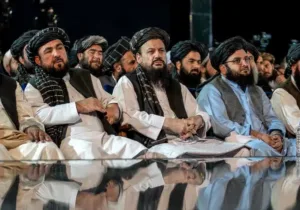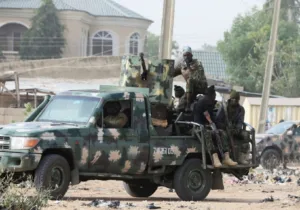The Islamic State appears to have gained a new lease on life in 2024. On March 22nd, its central Asian “province,” ISIS Khorasan or ISIS – K attacked a concert venue in Moscow, killing at least 137. The size and spectacle of the attack call to mind the group’s January attack outside of Tehran where it bombed a celebration of Qassem Soleimani, killing over 80. These high-profile strikes are surely cause for concern as they suggest that ISIS-K is refining its logistical capabilities and expanding its reach beyond Afghanistan and Pakistan. What’s more, they serve as a stark reminder that ISIS’s ideology continues to defy banishment to the dustbin of history, clinging to life still in a few corners of the world. Still, there are two silver linings that should comfort rather than alarm American policymakers. First, our light footprint counterterrorism strategy has not diminished the ability of our intelligence community to track terrorists and anticipate. their attacks. Second, that American officials warned adversarial nations about threats to their civilians is a testament to the higher moral standard of our intelligence community.
ISIS-K first made headlines when it killed thirteen American service members in Kabul during the withdrawal from Afghanistan in 2021. Though jarring, many believed the Taliban would be capable of defeating the group on its own and, indeed, that seemed to be the case. After a sharp spike in attacks in 2022, the number of attacks claimed by ISIS-K declined markedly in 2023. The average number of monthly attacks dropped from 23 per month after the American withdrawal to just four per month by July of that year. Additionally, in 2023 the Taliban claimed to have killed the mastermind behind the Kabul attack. But the group adapted and began expanding its theater of operations, first with an attack on a political rally in neighboring Pakistan in July. The attacks in Tehran and Moscow, as well as thwarted attacks in Western Europe, attest to the groups changing strategy from insurgent-style confrontation of Taliban forces to a regional terrorism campaign aimed to bolster recruitment and sow discord among its long list of enemies.
This resiliency and strategic creativity is common among ISIS’s regional affiliates (consider, e.g., its West Africa province in Nigeria) and testifies to the core group’s continued ideological appeal across time and national borders. After destroying the ISIS caliphate in 2019 and repeatedly decapitating its leadership, the group and its offshoots have consistently withdrawn back into the shadows, doubled down on their recruitment efforts, and reemerged with varying levels of success. That the group has failed time and again on its promises to topple regimes and usher in a golden age of true faith does not seem to register with each new batch of recruits. Nor do these failures seem to seriously temper the group’s ideological intensity; that even the Taliban is not extreme enough for ISIS-K says all one needs to understand just how uncompromising is this particular affiliate.
That ISIS-K appears to be expanding its operations and that its ideological fervor shows little sign of relaxing by no means suggest that policymakers should be alarmed or take a more confrontational approach to the problem of jihadism. Indeed, despite the American withdrawal from Afghanistan, U.S. counterterrorism efforts have proven effective. Al-Qaeda, for example, has seemingly failed to reconstitute after years of Taliban control in spite many predictions to the contrary. Moreover, the United States reportedly warned Iranian and Russia authorities ahead of time that terrorist attacks were imminent. That these attacks took place is more of a failure of Russian and Iranian intelligence services than an indictment of American counterterrorism strategy.
We may never know why these countries failed to anticipate ISIS attacks after receiving U.S. warning. It may be that their intelligence services are so conspiratorial that any word from American agencies is dismissed out of hand. Or, more likely, it may be that the two countries have been too focused on major conflicts in their own backyards to pay ISIS any attention. But, while these attacks represent intelligence failures for the Russians and Iranians, they also represent an intelligence success for America. Indeed, it is a testimony to how far our ability to track shadowy jihadist groups has come since the pre-9/11 era. If we are able to predict attacks in capitals of adversarial nations, there is reason to believe that our intelligence community can thwart any ambitions to attack the homeland.
Perhaps more important than the strategic concern is the moral victory of our intelligence agencies. “Moral” and “intelligence agencies” rarely appear in the same sentence; agencies like the CIA have a troubled history, particularly during the Cold War when its various supported coups brought tyrants to power in countries like Iran and Chile. Indeed, the agency trained the Iranian’s Shah’s SAVAK, a sort of pretorian guard whose brutality helped inspire the 1979 Islamic revolution. We should remember these immoralities, but also celebrate the moral clarity of our intelligence communities in warning adversarial nations about imminent threats to their civilians.
In more ways than one, the “Duty to Warn” policy, first issued in 2015 by Director of National Intelligence James Clapper, is a sign of the beliefs liberal democracies hold dear. The universalism of liberalism’s teachings on human equality and dignity inclines us to see all persons, regardless of nationality, as rights-bearing individuals meriting protection. This inclination is by no means infallible, to be sure. Yet despite being in a new cold war with Russia and Iran, American leaders rightly recognized that the geopolitical struggle with these countries should not blind us to the moral obligation to protect innocent life where we can. It is difficult to imagine Iranian or Russian officials today considering it a “duty” to warn American officials of possible threats to civilian life. Lastly, the “duty to warn” policy, while morally proper, is not purely an act of international charity. Instead, it implicitly reflects, even to tyrants, the potential for decent conduct and, in doing so, quietly challenges the agents of authoritarianism to reconsider the alleged moral inferiority of liberal regimes. More than a mere nicety, “duty to warn” is a subtle weapon that sows doubt in authoritarian pretenses to moral superiority over the West.







 Sponsor a student for Christianity & National Security 2024
Sponsor a student for Christianity & National Security 2024